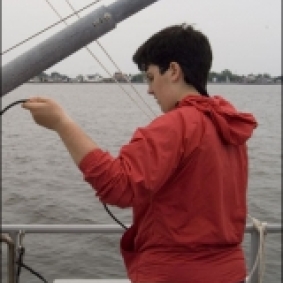Eight students will be presenting the summer work at the Ocean Sciences Meeting in March 2022!
Colette LeBeau, Maine Maritime Academy
Class Year:
2006Mentor:
Cindy Palinkas, Ph.D.Project Title:
Geochronology and Characterization of Grain Size and Trace Metals in Sediment Cores Collected from the Corsica River, Maryland
Abstract:
Flow, erosion, and bioturbation affect sedimentation in rivers. Metals can react with sediment particles and be deposited with the sediment. The Corsica River in Maryland is highly polluted from erosion and waste disposal, amongst other things. To determine the changes in sedimentation in the Corsica River over the past 100 y, two cores were collected from different locations on the river. Both cores were analyzed for grain size using a Sedigraph, and an alpha counter was used to analyze 210Pb. The downstream core was analyzed for the trace metals Pb, Cu, Zn, Mn, and Fe with a flame atomic absorption spectrometer. The results show that the downstream core has more sand in the surface layers, possibly from higher river flow. The upstream core has more clay and a higher sediment accumulation rate, indicating lower flow. Bioturbation is the primary cause of mixing in the top 12 to 16 cm of both cores. The increase in Pb, Cu, and Zn over time is directly related to the increase in industrialization and pollution. However, in recent years, the concentrations of Pb and Zn decrease due to pollution regulations. Mn concentrations correspond to concentrations of pyrite, suggesting that Mn is incorporated into pyrite. Fe concentrations show no pattern. Overall, the concentrations of all the metals analyzed were low relative to those of the Chesapeake Bay and Baltimore Harbor, suggesting that metals are not a major source of pollution in the Corsica River.




